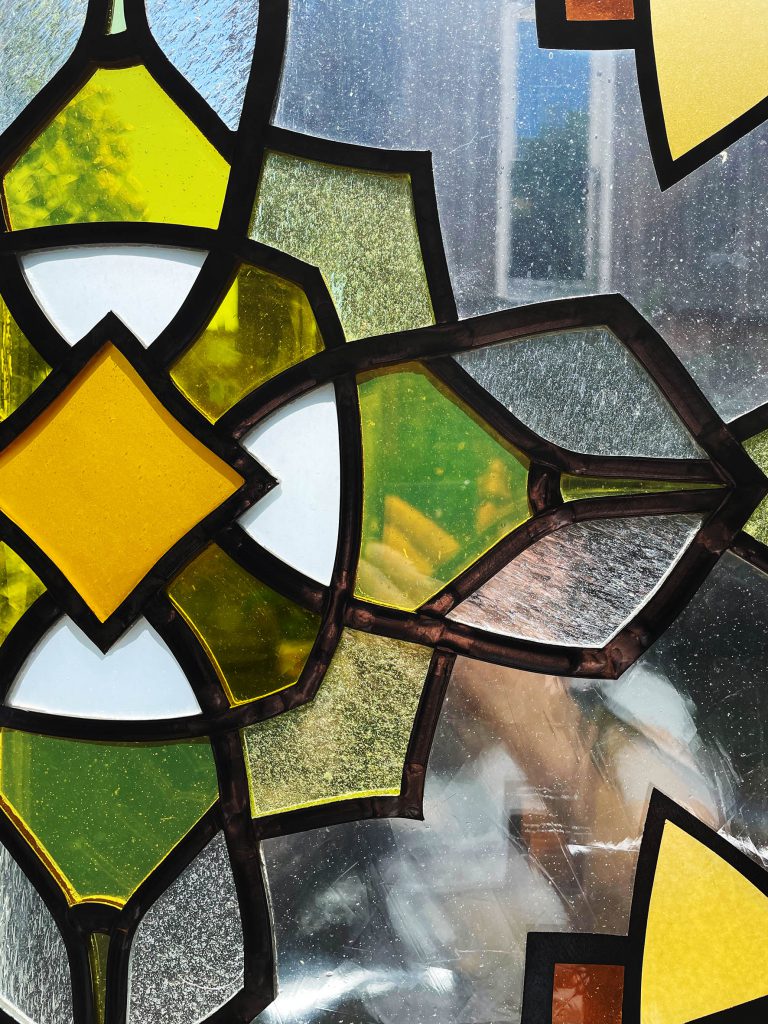
The Design
How did this design come into existence? Fiona Tan’s Australian grandmother’s brother fought in World War I to liberate Europe. He collected shards of glass from the cathedral of Reims, which was bombed in 1914, and took them home. He turned the glass into a kaleidoscope. As a kid, Tan played with this remarkable toy. It lay the foundation of the ideas for the church’s stained-glass window, with its theme The Light of Freedom.
To Tan, early church windows are predecessors to the movie theater: in both places, a story is told through light and colour. Following the theme, Tan seized the opportunity to create an artwork for this and future generations, combining the movement of light and colour.
The Great Window is a kaleidoscope in which every panel can be viewed as a film frame, inspired by the rhythmic detailing of medieval church windows and the toy from Tan’s childhood. The colour scheme calls to mind the sun rising over the North Holland landscape, with light tones at the bottom – a lot of white, warm yellow, orange and red hues – and cooler tones at the top: blue, purple, indigo. Each panel is unique. An exciting combination of old and new – a modern digital animation, carried out in a traditional technique, centuries old. The visitor can spend hours watching the ever-changing sun, light, and sky, looking through the brightly coloured glass.

Colours and Light on the Church Interior
Fiona Tan: ‘The church’s light is magnificent, no wonder Saenredam painted this church. Each cardinal point has its own characteristics. On the south side there’s a lot of sun, shining directly through the window. After 2023, sunlight will be shining through my artwork, and its colours will be reflected on the church floor and wall – I’m already looking forward to it.’
‘I’ve never worked with leaded windows, but I’ve studied the technique thoroughly. My design, created with state-of-the-art visual technology, is carried out using an age-old manual technique. It’s a great honor to be asked for this assignment and I love working with light, colour, and movement. I’ve done a lot of preliminary research by visiting as many churches as I could and I’ve seen the sunlight change: an occurrence which is new and notable each and every time. I can understand how something like that can be a subliminal or even spiritual experience.’
“Your eye travels through the window”
‘One could call stained-glass windows in medieval churches predecessors to watching a movie at the movie theater – both tell stories, imagined through changing light and colour. I want to create an artwork people want to look at for a long time. If you zoom in and let your eyes travel upwards, you’ll see movement and visual development in each panel, like turning a kaleidoscope. Each vertical series is like a filmstrip, a series of stills from an abstract movie. It’s as if your eye travels through the window. The window will be a festive artwork of light and colour: for visitors now, and for those in the future.


Choosing the Artist
After discussing guidelines for the selection of the artist, we asked external advisors Hendrik Driessen and Bart Rutten to offer suggestions. Both Driessen and Rutten are experts when it comes to contemporary visual art, and both have a large network in the art world. After creating a shortlist, it became apparent the Amsterdam-based artist Fiona Tan would be the preferred choice. According to Dutch newspaper Trouw Tan is one of the five most prominent contemporary Dutch artists. In September 2020 we asked her to make a preliminary sketch of the design.
Fiona Tan’s Oeuvre
Next to film, video and photography, Tan is mainly known for her spatial installations in which explorations of memory, time, history and visual images play a central role. She obtained a degree at the Gerrit Rietveld Academie and the Rijksacademie voor Beeldende Kunsten.
Her artworks have been exhibited worldwide in the past 25 years, and she represented The Netherlands in 2009 at the Venice Biennale. She has had solo shows in the Guggenheim Museum in Bilbao, the New Museum in New York, museums in Frankfurt and Vancouver, and her works are part of the collections of Tate Modern, Centre Pompidou, MCA Chicago and the Stedelijk Museum and Rijksmuseum in Amsterdam.





